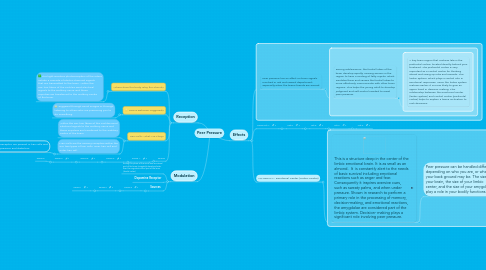
1. Reception
1.1. Where does the body relay the Stimuli?
1.1.1. The light-sensitive photoreceptors of the retina initiate a cascade of electro-chemical signals that are transmitted to the brain. Within the ear, hair fibres of the cochlea send electrical signals to the auditory nerve and those impulses are transferred to the auditory centre of the brain.
1.2. How is Behavior Triggered?
1.2.1. Triggered through visual images or through listening to others who are pressuring you to do something.
1.3. Hair Cells, What Are They?
1.3.1. Within the ear, hair fibres of the cochlea send electrical signals to the auditory nerve and those impulses are transferred to the auditory centre of the brain.
1.3.2. Hair Cells are the sensory receptors within the ear. two types of hair cells: inner hair cell and outer hair cell.
1.3.2.1. mechanoreceptor, are present in hair cells and respond to pressure and distortion.
1.4. Sources
1.4.1. Source 1:
1.4.1.1. Source 2:
1.4.1.1.1. Source 3:
2. Modulation
2.1. During this phase of the social and emotional part of the brain (amygdala) develops faster than the cognitive control part of the brain (frontal cortex)
2.2. Dopamine Receptor
2.3. Sources
2.3.1. Source 3
2.3.1.1. Source 2
2.3.1.1.1. Source 1
3. Effects
3.1. Peer pressure has an effect on brain signals involved in risk and reward department, especially when the teen’s friends are around.
3.1.1. During adolescence, the frontal lobes of the brain develop rapidly, causing axioms in the region to have a coating of fatty myelin, which insulates them and causes the frontal lobes to more effectively communicate with other brain regions. This helps the young adult to develop judgment and self-control needed to resist peer pressure.
3.1.1.1. A key brain region that matures late is the prefrontal cortex, located directly behind your forehead. The prefrontal cortex is very important as a control center for thinking ahead and sizing up risks and rewards. The limbic system, which plays a central role in emotional responses. Since the limbic system matures earlier, it is more likely to gain an upper hand in decision making. This relationship between the emotional center (limbic system) and control center (prefrontal cortex) helps to explain a teen’s inclination to rush decisions.
3.2. Source Link 1:
3.2.1. Link 2:
3.2.1.1. Link 3:
3.2.1.1.1. Link 4:
3.3. AMYGDALA : Emotional Center (Limbic Center)
3.3.1. This is a structure deep in the center of the limbic emotional brain. It is as small as an almond. It is constantly alert to the needs of basic survival including emotional reactions such as anger and fear. Consequently it inspires aversive cues, such as sweaty palms, and when under pressure. Shown in research to perform a primary role in the processing of memory, decision-making, and emotional reactions, the amygdalae are considered part of the limbic system. Decision- making plays a significant role involving peer pressure.
3.3.1.1. Peer pressure can be handled differently depending on who you are, or what your back ground may be. The size of your brain, the size of your limbic center, and the size of your amygdala all play a role in your bodily functions.

